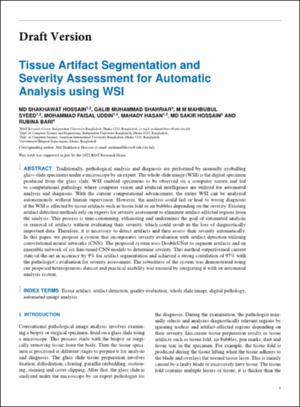| dc.description.abstract | Traditionally, pathological analysis and diagnosis are performed by manually eyeballing glass-slide specimens under a microscope by an expert. The whole slide image (WSI) is the digital specimen produced from the glass slide. WSI enabled specimens to be observed on a computer screen and led to computational pathology where computer vision and artificial intelligence are utilized for automated analysis and diagnosis. With the current computational advancement, the entire WSI can be analyzed autonomously without human supervision. However, the analysis could fail or lead to wrong diagnosis if the WSI is affected by tissue artifacts such as tissue fold or air bubbles depending on the severity. Existing artifact detection methods rely on experts for severity assessment to eliminate artifact-affected regions from the analysis. This process is time-consuming, exhausting and undermines the goal of automated analysis or removal of artifacts without evaluating their severity, which could result in the loss of diagnostically important data. Therefore, it is necessary to detect artifacts and then assess their severity automatically. In this paper, we propose a system that incorporates severity evaluation with artifact detection utilizing convolutional neural networks (CNN). The proposed system uses DoubleUNet to segment artifacts and an ensemble network of six fine-tuned CNN models to determine severity. This method outperformed current state-of-the-art in accuracy by 9% for artifact segmentation and achieved a strong correlation of 97% with the pathologist’s evaluation for severity assessment. The robustness of the system was demonstrated using our proposed heterogeneous dataset and practical usability was ensured by integrating it with an automated analysis system. | en_US |
